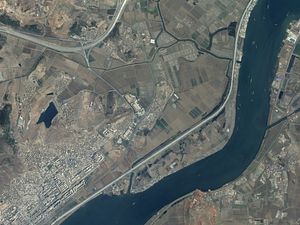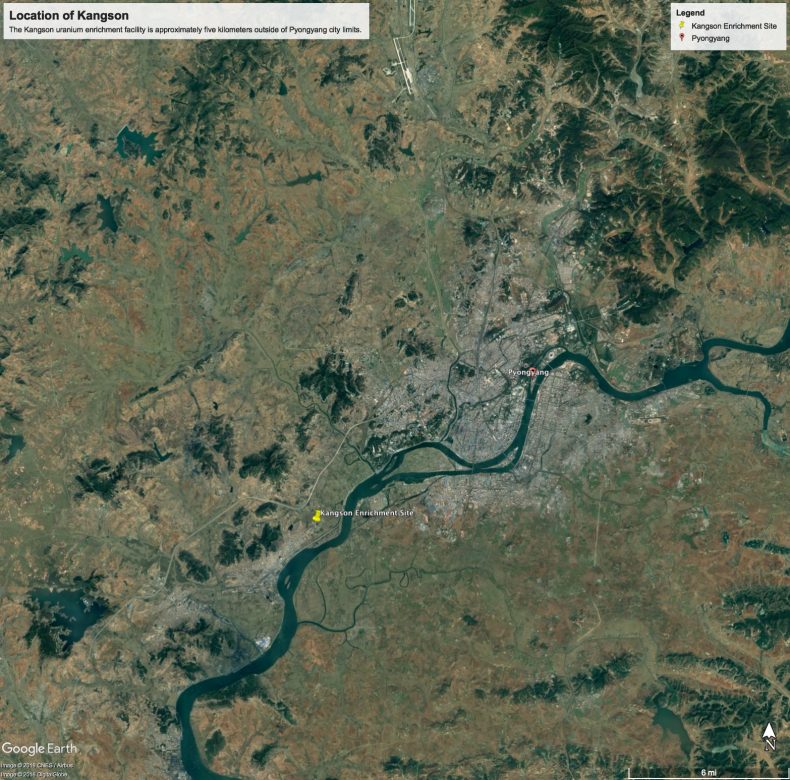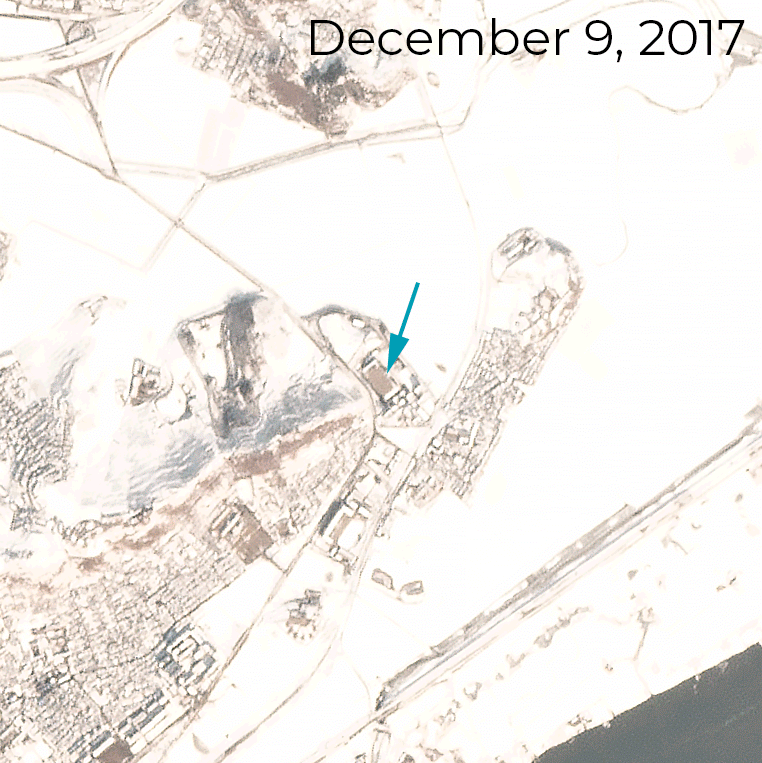Beginning in the early 2000s, North Korea began building a discreet, largely unnoticed, cluster of buildings, not far from the banks of the Taedong river, a few kilometers south-southeast of the North Korean capital of Pyongyang. Located on the eastern end of Chollima, a town best known for hosting a massive steel manufacturing complex since the Japanese occupation of the Korean Peninsula, the facility had drawn no public attention—until now.
The facility is North Korea’s first covert uranium enrichment facility, known by the U.S. intelligence community as the Kangson enrichment site. It is where, for more than a decade—possibly as long as fifteen years—North Korea has been enriching uranium for use in nuclear weapons. It is older than the well-known enrichment site operated by North Korea since at least 2010 at the old Fuel Fabrication Plant at Yongbyon. The Kangson site is one of two known North Korean covert enrichment sites.
The Diplomat, along with a team of open source researchers at the Center for Nonproliferation Studies at the Middlebury Institute of International Studies at Monterey led by Jeffrey Lewis, was able to locate the Kangson covert enrichment site. Separately, a U.S. government source with knowledge of the latest intelligence on North Korea’s nuclear weapons program, when asked, confirmed to The Diplomat that the discovered site corresponded to the covert enrichment site referred to by the U.S. intelligence community as Kangson. U.S. intelligence has monitored this site for more than a decade.
The Kangson Enrichment Site
The Kangson site is built around a single, large building, assumed to contain the main gas centrifuge cascades, which output uranium highly enriched in uranium-235 and suitable for use in nuclear weapons. The main hall is 50 meters long and 110 meters wide. Its height is unknown and it’s also unclear if the building may have an underground area. The entire site, including the main hall, the long entryway road, and the associated support buildings, is surrounded by a one kilometer-long wall perimeter, suggesting that it is a high security area.
Curiously, the secure Kangson facility sits just one kilometer off the Pyongyang-Nampo expressway, a major North Korean road that connects the country’s capital to the port city of Nampo on the Yellow Sea. The entrance to the Kangson enrichment site sits just one kilometer off the main expressway, along a road that connects it to the town of Chollima. Visitors from Pyongyang to Chollima traveling by road would likely drive past the Kangson site.
A Suburban Enrichment Plant: Kangson Relative to Pyongyang
The site’s proximity to Pyongyang is notable; the enrichment site was built a little more than five kilometers away from the city’s Mangyongdae neighborhood, North Korean founder Kim Il Sung’s birthplace, per North Korean propaganda. Thus, for more than a decade, North Korea has been enriching uranium in what is effectively a Pyongyang suburb, on the doorstep of Kim Il Sung’s mythologized birthplace.
The site’s relatively good connectivity may serve an important role in enabling its smooth operation. Large gas centrifuge facilities like Kangson require regular resupply and depleted uranium tail disposal. Satellite imagery from recent years seen by The Diplomat shows evidence of regular visits by a number of large vehicles and trucks. The western side of the main hall appears to have a large opening to allow trucks to enter the building as well. These vehicles could transport important materials for the uranium enrichment process in and out of the facility, including uranium hexafluoride and depleted ‘tails’. They could additionally transport highly enriched uranium to where its needed, including North Korea’s Nuclear Weapons Institute. (The Kangson site is also not far from the Chamjin Missile Factory.)
The Kangson Enrichment Site, Annotated
To the west, the main building is flanked by what appears to be a cluster of residential multi-story buildings. These buildings, which appear to have as many as seven stories, stand out from the nearby residential buildings outside of the Kangson enrichment site walled complex, where there are mostly simple homes. These buildings could serve as housing for the scientists, engineers, and support staff involved with ongoing work at the Kangson site, Lewis told The Diplomat. The statue implies an unusual role for the site compared to nearby facilities in Chollima.
While analyzing the purpose of the Kangson facility, Lewis and his team reviewed North Korean propaganda footage of Kim Jong Il and Kim Jong Un visiting and inspecting a range of significant facilities in and around the industrially significant Chollima area. The building now being scrutinized as the Kangson enrichment site was the sole large facility that was not accounted for in the area among these visits by both leaders; North Korean propaganda had carefully excluded visits to this site, if they had occurred, highlighting its potential sensitivity and national defense use.
But at least one leadership visit likely did occur—probably by the late North Korean leader Kim Jong Il at least as early as 2009. Perpendicular to the center of the main hall at Kangson, North Korea has erected what appeared to be a monument or a mural. Another such monument—likely an obelisk—had been erected along the road providing an entrance to the main facility area. Both monuments were erected during Kim Jong Il’s leadership tenure.
These kinds of murals and monuments have been seen at other North Korean sites with significant national defense roles, such as the Chemical Materials Institute, which Kim Jong Un visited last August, or the Chamjin Missile Factory. These murals, in many cases, commemorate or honor a visit by the country’s supreme leadership and stand at these sites for their propaganda value. The existence of the monument and mural, if not definitive evidence of a visit by Kim Jong Il, further underline Kangson’s importance.
Another signature that Lewis and his team noticed in assessing the Kangson site as a candidate enrichment site was continuous year-round heat generation at the main hall. Across eight wintertime images between 2017 and 2018, even as the surrounding area was covered in snow, including the rooftops of nearby buildings, the large main hall at Kangson was not, suggesting internal heat generation. That alone cannot substantiate if multiple gas centrifuge cascades lie within, but combined with the other signatures, suggest at least significant military-industrial role for the facility.
Year-Round Heat Generation at Kangson Enrichment Plant
“What we feel comfortable saying is that we can’t say whether it is, or is not, an enrichment plant,” Lewis noted. But, “this is a suitable building that has a number of signatures consistent with that and no obvious inconsistencies,” he continued. Whatever the purpose of the site, Lewis continued, this facility at Kangson was “clearly a sensitive national defense site.”
Assuming the Kangson hall comprised a single floor equipped with cascades of Pakistan-sourced North Korean variants of the P2 centrifuge cascades, the floor area alone would suggest a highly enriched uranium output 20 percent larger than the expanded gas centrifuge facility at Yongbyon. A U.S. intelligence source told The Diplomat, meanwhile, that the latest U.S. estimates are that Kangson’s output is twice that of Yongbyon. Lewis noted that, assuming North Korea was using the same P2 centrifuges it is likely still operating at Yongbyon, the physical size of the main hall at Kangson did not imply a significantly larger enrichment capacity.
Finding Kangson
In May 2018, the Washington Post, citing work by David Albright of the Institute for Science and International Security, first reported the existence of an underground covert uranium enrichment site in North Korea—a site “believed to be called Kangsong.” Albright underlined North Korean defector testimony in support of the existence of this covert enrichment site. While nonproliferation experts had long expected that North Korea had covert uranium enrichment sites outside of the known facility at Yongbyon, no details had been made public about alternative enrichment sites.
A June 30 report by the Washington Post and a separate analysis at NKPro revealed the U.S. intelligence name for the site as Kangson, providing Lewis and his team with a key piece of data. Kangson was the old Japanese colonial-era name for Chollima and is in use by the U.S. intelligence community to still describe this enrichment site. (U.S. intelligence often uses known nearby city names to name North Korean military sites that may be of interest.) Lewis began scouring the area for any facilities that might match a covert enrichment site, ultimately coming across the enrichment facility after eliminating other facilities nearby.
The United States “took note of construction in 2007, but didn’t suspect a nuclear role until 2010,” a U.S. intelligence source told The Diplomat regarding the history of the U.S. intelligence community’s knowledge of the Kangson site. Another source had earlier told The Diplomat that the U.S. Defense Intelligence Agency’s 2017 estimate on North Korea’s fissile material stockpile and accrual—sufficient for at least 60 weapons and growing at a rate of 12 per year—was based off the assumed total highly enriched uranium output of Kangson and Yongbyon. Since then, U.S. military intelligence has detected the existence of a third covert enrichment site.
The precise timeline of Kangson’s development and commencement of operations is unclear.
Satellite imagery available from 2001 in Google Earth shows that the facility did not exist that year; the area where it stands today was undeveloped farmland. The next most recent imagery available on Google Earth—from 2009—shows a virtually completed facility. North Korea has made some additions to the residential area within the compound since then, but the rest of the site remains mostly unchanged.
Lewis and his team were able to acquire a satellite image from April 2002 that showed the Kangson site’s main enrichment hall under construction. The timing of the construction matches North Korea’s suspected transition from an exploratory interest in an HEU path to the bomb to serious investment in gas centrifuge technologies. Lewis estimates that the facility may have been operating as early 2003, based on a lack of wintertime snow cover on the completed main enrichment hall. (In January 2003, North Korea announced its withdrawal from the Nuclear Nonproliferation Treaty.) The 2002 construction image additionally suggests that North Korea likely did not plan for an underground section to the main enrichment hall, limiting the floor space available to support gas centrifuge cascades.
Kangson Under Construction in 2002
The Kangson site under construction, seen here in an April 2002 image. (Image courtesy of Geo4NonPro.)
North Korea is known to have received assistance on gas centrifuge technology in the late-1990s from Pakistani nuclear scientist Abdul Qadeer Khan and, by 2002, the U.S. intelligence community had detected North Korea’s covert pursuit of a uranium path to a nuclear weapon, resulting in the collapse of the Agreed Framework later that year. It’s unclear if Kangson may have been part of the reason the United States assessed that North Korea was pursuing a covert uranium enrichment program. However, if U.S. intelligence had not assigned a nuclear role to the site until 2010, then it’s likely that the 2002 assessments were likely based on North Korea’s interest in importing components for use in a scaled-up gas centrifuge program.
By 2010, North Korea had established six cascades of 2000 P2 centrifuges at Yongbyon—a fact that they were happy to share with Siegfried Hecker, an American nuclear scientist and a former director of the U.S. Department of Energy’s Los Alamos National Laboratory. Hecker visited in November that year with low expectations. “Quite frankly, I was expecting not much, sort of a couple of dozen centrifuges,” he said in 2011, following his visit. Instead, he found a state-of-the-art facility at Yongbyon.
Kangson, meanwhile, had likely served as North Korea’s first major gas centrifuge facility, allowing the country’s nuclear scientists to experiment with initial gas centrifuge cascades before setting up the facility at Yongbyon knowing that it would one day be shown to foreign scientists. In the end, North Korea successfully kept a lid on Kangson and no U.S. administration saw it fit to disclose knowledge of the site.
Implications for Diplomacy With North Korea
In July 2018, the United States and North Korea find themselves entering yet another round of working group-level talks on “denuclearization” and a range of other issues related to the cadence of the broader bilateral relationship, one still colored by mistrust after more than two decades of similar talks. Prior to his diplomatic charm offensive, Kim Jong Un began the year with a New Year’s Day address in which he directed the country’s munitions industry and nuclear weapons complex to mass produce ballistic missiles and nuclear warheads.
Nothing since his January address would suggest that the centrifuges that Kangson, Yongbyon, or the third, unknown enrichment site have stopped spinning. For the United States, a major denuclearization objective will be to deprive North Korea of access to fissile material. However, given the reality of North Korea’s advancements in nuclear weapons and ballistic missile technology, the United States might find itself forced to accept a freeze agreement in the interim.
Any such agreement would hinge on North Korea self-declaring sites and covert sites like Kangson would have been tempting to conceal. North Korea could have made a bet that the U.S. intelligence community did not know about its ongoing activities at this site and that submitting to a verifiable freeze in enrichment activity at Yongbyon would suffice. Per a recent report by NBC News, U.S. intelligence has calculated that North Korea is actively intending on deceiving the United States, likely by concealing key sites and other measures.
With the veil lifted from Kangson, North Korea may be less willing to conceal the site, should negotiations with the United States proceed further.
Ankit Panda is a senior editor at The Diplomat, where he writes on politics, security, and geopolitics. He is also an adjunct senior fellow at the Federation of American Scientists, where he works on nuclear weapons and security in Asia. Follow him on Twitter @nktpnd.
Jeffrey Lewis and his team have made historical satellite imagery of the Kangson site available at Geo4NonPro, a crowd-sourced geospatial analysis resource.




































